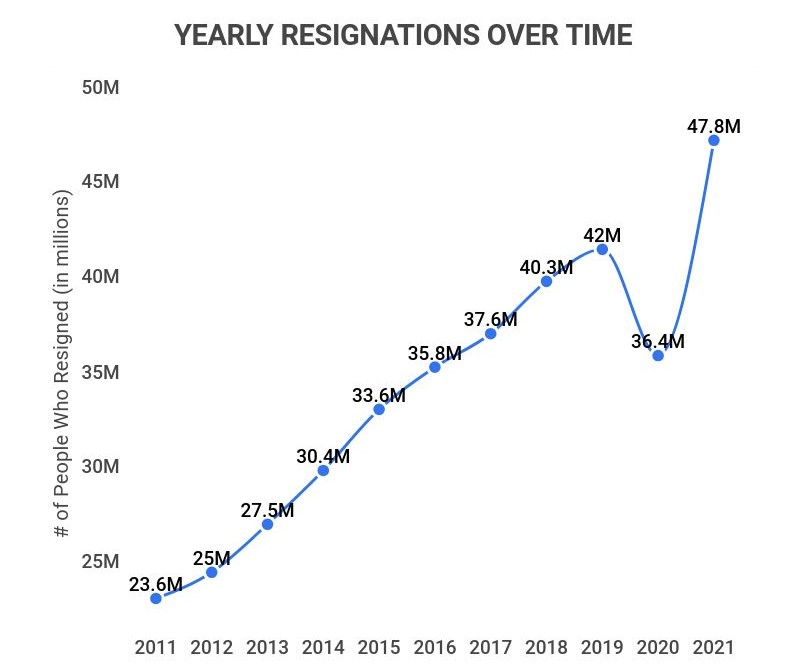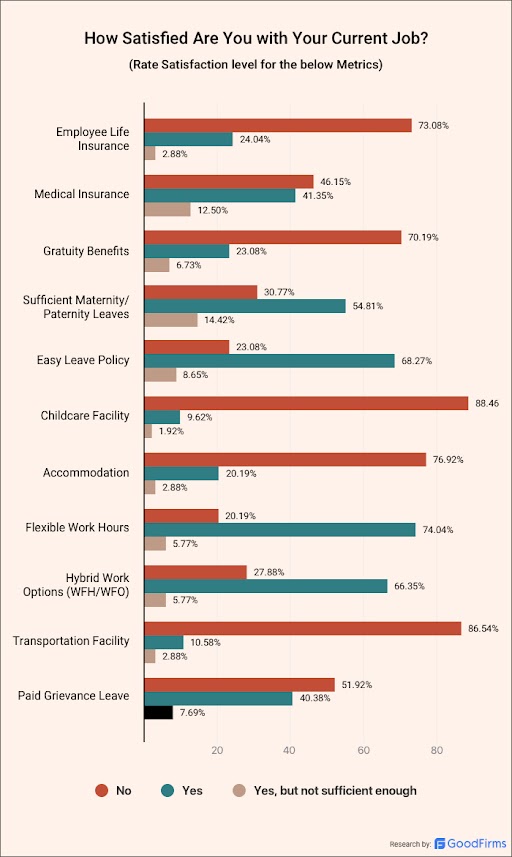
The Great Resignation is an ongoing economic trend in which employees voluntarily resign from their jobs en-masse. It started in early 2021. There are many causes behind this trend, like wage stagnation amidst the rising cost of living, job dissatisfaction, and the Covid-19 pandemic.
The stats are pretty alarming. Forty-seven million Americans left their jobs in 2021, with an average of 3.98 million quitting their positions every month. It peaked in November, when 9.8 million people left. So, 23.5% of the total US workforce resigned from their jobs in 2021.

(Source: Zippia)
Companies are scratching their heads on what to do. Those in top positions are desperately trying to find ways to reduce employee attrition rate. So, based on GoodFirms research, this blog will share what businesses can do to retain their employees. Please continue reading to find out.
The Equity Theory of Motivation
The equity theory states that employees are motivated to work based on two factors:
- Their pay (which must be fair in the first place)
- Their perception (how well they are paid compared to others)
If employees find out they are being paid less, they might start to put less effort into it or look for another job. So, it is the employers' responsibility to provide fair pay to everyone working in their company.
According to Pew Research, most workers quit their jobs due to low pay.

(Source: Pew Research)
But, how to implement the equity theory of motivation? Here are some ways to do it.
- Ensure a fair balance among team members. All should receive the same compensation for an equal amount of work.
- When setting compensation standards, research external positions for information about salary, benefits, and incentives.
- Team members may have different views on specific inputs and outcomes. To form an actionable plan, ask individual members what motivates them. Show your team that you appreciate their contributions, which will help them stay motivated and happy in your workplace.
Here are two examples of how companies implemented the equity theory of motivation.
Google has decentralized control. Employees work independently, and their views and ideas are respected. Managers do not micromanage their employees' work, and people can choose what project to work on and determine their work schedules.
All this makes employees feel they are being treated fairly, which motivates them.
McDonald's recently announced that they had achieved equal pay for women and other underrepresented groups across company-owned restaurants and corporate employees in the US.
Studies show that women worldwide are paid 20% less than their male counterparts. McDonald's took the issue head on, began adjusting salaries, and invested in equal pay within their business. They have been successful in their endeavors.
The company said that it employs more than 180,000 people and everyone, irrespective of gender, now receives equal pay for comparable work at all company-owned restaurants.
Offer Flexibility and Hybrid Work Options (WFH/WFO)
The hybrid work model provides flexibility to employees compared to the traditional one. It allows them to finish the work when and where they are most productive.

Some employees like to work early in the morning, while others prefer to do it in the evening. A hybrid work model allows them to choose their work schedule and locations.
So, how can companies implement a hybrid work model for their employees?
First, don't panic! Everyone is figuring out how to make it work. So problems will arise naturally. Here is what you should do:
- Obtain regular feedback and then update your approach to hybrid working based on the collected data. Gather information from your customers and clients, check if they are happy, and make adjustments if needed.
- Don't make anything permanent. See how things are going and keep talking to the people about it.
- Make minor adjustments and give more clarity if required. People like guidance, so provide the framework but don't be too rigid about it.
- Please take it as a learning process. You can't create a perfect system as the situation may change in a few weeks, months, or years. So, keep your approach flexible.
- A significant risk with the hybrid working model is that it creates two tribes that hate each other. A survey revealed that people of Gen Y prefer flexible working, but Gen X and Z tend to dismiss it. So, choose a middle-out approach. Let each team decide what works for them and trust them to make a sensible decision. It ensures everyone is committed to the solution and forges a level playing field.
- Create transparent policies and principles regarding eligibility for a hybrid working model. It's not possible to treat everyone the same way, but there should be parity of opportunity regarding flexible working.
- A survey revealed that employees would likely quit their jobs in 2022 unless they received more face-to-face contact with their leaders. So, get closer to your team members and connect with them regularly. Hold meetings to check in on your team members and see how they are faring. It can help resolve problems regarding career frustrations and loneliness.
Lastly, treat each employee as an individual. Demonstrate your understanding that people will always want and need different things at various stages of their careers, no matter how they prefer to work. Build a culture that prioritizes flexibility, inclusivity, and wellness.
Establish a Transparent Salary Structure and Eliminate Non-Compete Policies
Microsoft is implementing greater pay transparency and eliminating non-compete clauses for most employees. They will publicly disclose salary ranges in all internal and external job postings across the USA starting January 2023.
Microsoft is also removing non-competition clauses from US employee agreements and will not enforce the existing ones in the country. Although some exceptions exist for senior leadership (partners and executives), it's still a great start.
Employees in the US will not be restricted by a non-compete clause when seeking employment with another company that might be a competitor of Microsoft.
It's a massive reform as, previously, employees leaving for companies like Google would occasionally lead to legal battles or even flying chairs if you believe the rumors.
There can never be a better time than now to eliminate non-compete policies and establish a transparent salary structure to survive the current turbulent times. Just like Microsoft, other companies must now follow suit.
Expand Paid Time Off
Recently, the US supreme court reversed Roe V Wade, ending the constitutional right to abortion that was upheld for nearly half a century. It's now left to states to decide whether to ban abortion or not. Some states might make it illegal to have an abortion.
So, how can companies support their female employees in such times? By expanding the paid time off.
Often workers have to drive hundreds of miles for care unavailable to their state. They need time off work. Access to paid leaves is available but only to higher-wage earners. Low-end ones don't have sick leaves or vacation time. Such employees will be left in a difficult spot if they need to travel to another state for an abortion.
Low-end wage earners don't even get unpaid time off unless covered by the family and medical leave act, and their problem qualifies as a severe health condition. They are left at the mercy of their managers.
An employee without vacation or sick leave driving to another state for medical care isn't getting paid. Those making $15 per hour will lose a week of work for an out-of-state abortion. Plus, they will have to bear the extra cost that goes into the procedure.
Also, I am not saying that companies should break the state's law. Companies don't have to know why an employee is taking a leave. They should be willing to provide leaves without asking for any reason. That way, businesses won't be breaking any law, and employees can travel to another state if they choose an abortion.
So, expand the sick leaves and vacation time for the employees.
For Further Reading
Check out the GoodFirms research on Great Resignation to further understand why the employee attrition rate increased after the pandemic. You will also gain insights on additional steps organizations can take to retain workers in your company.
